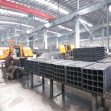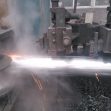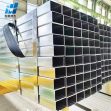Some popular types of glass curtain wall systems used in commercial buildings today
In most of modern commercial building construction, curtain wall facade systems are often considered part of a building envelope in applications. And such a glazing system requires careful integration with other adjacent structural elements such as wall claddings, roofs, and wall details.

Glass curtain wall systems are lightweight aluminum-framed facades housing glass or metal panels. These glazing systems don’t support the weight of a roof or floor. Instead, gravity loads and wind resistance transfer from the surface to the building’s floor line. In the current market, there are some popular types of glass curtain wall system in commercial building applications:
-Pressure-equalized rain screen systems are the best choice if you would like a system to resist air and water infiltration. A gasket surrounds the face of the glass and creates a pressure equalized chamber that forms an airtight barrier. The outside face of the glass and accompanying exterior glazing materials with the aluminum framing create a rain screen and shed water away. This type of curtain wall system also does a fair job of transferring wind loads.
-Water-managed systems incorporate drains and weeps. These systems are designed to resist water infiltration, but they make no effort to create an air barrier or “zone-glaze”. This means that a larger amount of water is forced into the system and must be weeped away. Since no air barrier exists, the pressure differential between the glazing pocket and the interior may be strong enough to force water vertically higher than interior gaskets. This results in leaks.
-Face-sealed systems require continuous and perfect seals between each glass unit and between all other frame members. The long-term durability of these seals is minimal. Patching these systems may require glazing tape.
In practical applications, since different curtain wall costs in construction budget, you can make a rational choice after thinking twice. In addition, the thermal efficiency of a glass curtain wall system depends on the glazing infill panel and the frame construction. Since aluminum has a high degree of thermal conductivity in use, it can transfer energy (heat) very rapidly. This results in energy loss. Implementing thermal breaks constructed of non-conductive materials is a useful practice that increases energy efficiency. Furthermore, improving heat efficiency also depends on the use of low-e and spectrally selective glass coatings. In a long run, high performance coatings can significantly increase insulation and improve comfort for a building’s occupants.
Tel: +86 18202256900 Email: steel@fwssteel.com









